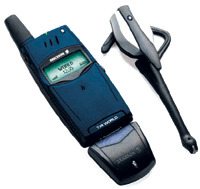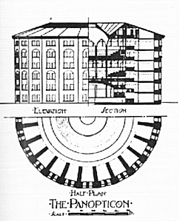Bluetooth, Destroyer of Holes
Sheep T. Iconoclast on Bluetooth's stab at the Holy Grail of the communication age – wireless networking
 It sometimes seems that in business, as in physics, there is a law stating that, for every action, there is a opposite and equal reaction. When, for example, Microsoft & Co. embarked on a multi-billion dollar project to create an orbiting network of satellites for transmitting mobile phone signals (see Mute9), Nokia, Panasonic, Psion, Motorola and Ericsson formed a company – Symbian – to make modular networks only 10 meters across.
It sometimes seems that in business, as in physics, there is a law stating that, for every action, there is a opposite and equal reaction. When, for example, Microsoft & Co. embarked on a multi-billion dollar project to create an orbiting network of satellites for transmitting mobile phone signals (see Mute9), Nokia, Panasonic, Psion, Motorola and Ericsson formed a company – Symbian – to make modular networks only 10 meters across.
Look at the back of any computer and you will see a growing collection of holes: RS232, phone sockets, sound connectors, microphone connectors, USB, Firewire, Tbase 10 ethernet, external drive connectors – the list goes on. This proliferation of orifices is reflected in many high street electronic devices: PDAs, phones, digital cameras – all are proud bearers.
 Bluetooth, a wireless networking specification named after 10th century Danish King Harald 'Blue Tooth' II and championed by Symbian and the likes, aims to eliminate all these cables, connectors and genderbenders. If, for example, a Bluetooth enabled chip resided in both your camera and laptop, you could simply transfer digital data between them without having to make a physical connection. The Special Interest Group promoting Bluetooth, which already comprises an enormous list of official signatories, envisages a future in which you can walk home, automatically have the door unlock, the lights come on, and the burglar alarm turn off in response to the mere presence of your mobile phone. This is, of course, also a future in which you can buy electronically: walk into a cinema, airport, hotel and your mobile phone will order and pay for everything, effectively functioning as a sort of universal boarding ticket.
Bluetooth, a wireless networking specification named after 10th century Danish King Harald 'Blue Tooth' II and championed by Symbian and the likes, aims to eliminate all these cables, connectors and genderbenders. If, for example, a Bluetooth enabled chip resided in both your camera and laptop, you could simply transfer digital data between them without having to make a physical connection. The Special Interest Group promoting Bluetooth, which already comprises an enormous list of official signatories, envisages a future in which you can walk home, automatically have the door unlock, the lights come on, and the burglar alarm turn off in response to the mere presence of your mobile phone. This is, of course, also a future in which you can buy electronically: walk into a cinema, airport, hotel and your mobile phone will order and pay for everything, effectively functioning as a sort of universal boarding ticket.
Conceptually, this kind of ad-hoc network is based on the Internet protocol TCP/IP. However, in the Bluetooth universe nothing is fixed – like commercial alliances, networks are transitory and, when convenient, broken. Whenever and wherever two Bluetooth-enabled machines come within 10 meters of each other, a network comes into being. Symbionics (a UKbased chip manufacturer) has already built a 9mm by 9mm 'Bluetooth' on a chip. You could conceivably use it to build an invisible 56kbits per second link from your computer to your printer. Alternatively you could transmit MP3 files to your digital walkman or just directly to a pair of headphones.
 However, the ability to walk into your office and print from your laptop implies that your identity (and permission to print) is kept with that printer and that laptop, also enabling detailed universal ambient surveillance. Given the general willingness to exchange privacy for utility, the digital Panopticon looks set to thrive. Unless a third universal law of social counterreaction makes itself manifest, phoning your fridge to find out how much milk is left or finally connecting your laptop to your printer without hours of struggling may turn out to have a pretty hefty price tag attached.
However, the ability to walk into your office and print from your laptop implies that your identity (and permission to print) is kept with that printer and that laptop, also enabling detailed universal ambient surveillance. Given the general willingness to exchange privacy for utility, the digital Panopticon looks set to thrive. Unless a third universal law of social counterreaction makes itself manifest, phoning your fridge to find out how much milk is left or finally connecting your laptop to your printer without hours of struggling may turn out to have a pretty hefty price tag attached.
[www.bluetooth.com][www.motorola.com/bluetooth][www.symbian.com]
Sheep T. Iconoclast<sheepATovinity.com>
Mute Books Orders
For Mute Books distribution contact Anagram Books
contact@anagrambooks.com
For online purchases visit anagrambooks.com







